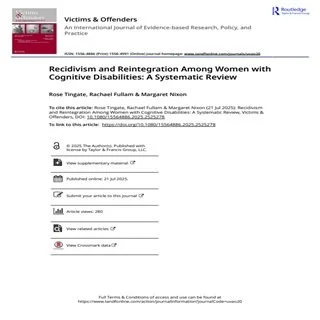By Rose Tingate , Rachael Fullam , and Margaret Nixon
Research has largely neglected the intersection of gender and disabil-ity in reintegration, resulting in a poor understanding of the reintegra-tion needs of women with cognitive disabilities. This paper useda systematic review of research published between 1995 and 2024 todevelop a profile of formerly incarcerated women with cognitive dis-abilities and their needs on reentry. Twelve studies met inclusioncriteria, and a content analysis revealed themes of disadvantage, dis-connection from family and support networks, mental illness, andunmet criminogenic needs. The limited research on the reintegrationneeds of formerly incarcerated women with cognitive disabilities high-lights significant challenges, including service gaps and specificvulnerabilities.
Victims & Offenders, 1–24.



